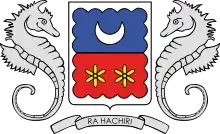Masonjoany
Masonjoany (Malagasy pronunciation: [masund͡zuanʲ]) (or msindanu or msindzano in Comoros and Mayotte) is a cosmetic paste and sunscreen made of ground wood. It is worn as a protective and decorative mask by women and girls in Madagascar, Comoros, and Mayotte. In Madagascar, the paste has yellow and white forms, with yellow masonjoany being derived from the wood of the tabàky or Madagascar sandalwood (Coptosperma madagascarensis), and white masonjoany deriving from the wood of the aviavy or fihamy tree (Ficus grevei).[1] In Comoros, the most commonly used tree for msindzano is Indian sandalwood (Santalum album).[2] The wood is ground against a surface of ceramic, stone, or coral skeleton, and combined with water and oil to make the paste.[3][4] The practice in Madagascar originates from cultural exchange between Malagasy natives and Indian merchants in Nosy Be.[5][6]
.jpg.webp)

Masonjoany is both protective and decorative: women wear it as sunscreen and insect repellent, and sometimes paint it in natural and abstract designs with a mix of contrasting white and yellow pastes. Common motifs in decorative masonjoany include flowers, stars, and leaves.[5] Other benefits associated with masonjoany in Madagascar include anti-aging, eliminating skin impurities, and cleansing the skin. Other associated benefits in Comoros include the lightening of skin as well as treatment of medical ailments like eczema, acne, and allergies.[3]
Masonjoany in Madagascar is also worn for religious rituals and beauty pageants. Molecular biologist Gianfranco Rasuelo reported that a Malagasy woman he had met on the street had told him that yellow masonjoany was spread on the faces of widows in mourning, but noted that this information is apocryphal.[3] The paste is typical of Madagascar's Northwestern coastal region, particularly by Sakalava and Vezo women in the provinces of Nosy Be, Antsiranana, and Toliara—though it has spread throughout the island and can now be found adorning women's faces as far as the Central Highlands.[3] The mask is ubiquitous throughout Mayotte, and is common, though waning in popularity, in Comoros.[7]
See also
- Thanaka – Cosmetic paste made from ground bark, common in Myanmar
- Borak (cosmetic) – Cosmetic for sun protection
- Culture of Mayotte
- Culture of Madagascar
- Women in Madagascar
References
- Niaina Casimir, Miray (2016). Valorisation du Ficus Grevei dans le domaine de la cosmétologie (in French). Univ Européenne. pp. 19, 78. ISBN 978-3841618337.
- Misra, Biswapriya B.; Dey, Satyahari (12 November 2013). Biological Activities of East Indian Sandalwood Tree, Santalum album (Report). PeerJ PrePrints.
- Mesa, Camillo La; Ranalison, Oliarinony; Randriantseheno, Lovasoa N.; Risuleo, Gianfranco (27 July 2021). "Natural Products from Madagascar, Socio-Cultural Usage, and Potential Applications in Advanced Biomedicine: A Concise Review". Molecules. 26 (15): 4507. doi:10.3390/molecules26154507. ISSN 1420-3049. PMC 8348691. PMID 34361660.
- "Le premier masque de msindzano sans corail |Parc naturel marin Mayotte". parc-marin-mayotte.fr (in French). Retrieved 30 July 2023.
- "Painting on Tradition in Madagascar". www.peacecorps.gov. Retrieved 4 July 2023.
- Nunoo, Ama (28 September 2020). "Why women in the West and South of Madagascar paint their faces". Face2Face Africa. Retrieved 6 July 2023.
- "Transmission intergénérationnelle de la préparation du Msindzano, masque de beauté au bois de santal". Mayotte la 1ère (in French). 31 July 2017. Retrieved 30 July 2023.


